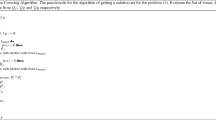Abstract
An algorithm that gives an approximate solution of a desired accuracy to a system of linear inequalities specified with approximate data is presented. It uses knowledge that the actual instance is feasible to reduce the data precision necessary to give an approximate solution to the actual instance. In some cases, this additional information allows problem instances that are ill-posed without the knowledge of feasibility to be solved.
The algorithm is computationally efficient and requires not much more data accuracy than the minimal amount necessary to give an approximate solution of the desired accuracy. This work aids in the development of a computational complexity theory that uses approximate data and knowledge.
Similar content being viewed by others
References
L. Blum, M. Shub and S. Smale, “On a theory of computation and complexity over the real numbers: NP-completeness, recursive functions and universal machines,”Bulletin of the American Mathematical Society 21 (1989) 1–46.
J.W. Daniel, “On perturbations in systems of linear inequalities,”SIAM Journal on Numerical Analysis 10 (1973) 290–307.
J.W. Demmel, “On condition numbers and the distance to the nearest ill-posed problem,”Numerical Mathematics 51 (1987) 251–289.
C. Eckart and G. Young, “The approximation of one matrix by another of lower rank,”Psychometrika 1 (1936) 211–218.
J. Edmonds, “Paths, trees, and flowers,”Canadian Journal of Mathematics 17 (1965) 449–467.
S. Filipowski, “Towards a computational complexity theory that uses approximate data and knowledge,” Ph.D. Dissertation, Cornell University (Ithaca, NY, 1993).
G.H. Golub and C.F. Van Loan,Matrix Computations (The Johns Hopkins University Press, Baltimore, MD, 2nd ed., 1989).
E. Hansen, “On the solution of linear algebraic equations with interval coefficients,”Linear Algebra and its Applications 2 (1969) 153–165.
A.J. Hoffman, “On approximate solutions to systems of linear inequalities,”Journal of Research of the National Bureau of Standards 49 (1952) 263–265.
Z.Q. Luo and P. Tseng, “Perturbation analysis of a condition number for linear systems,”SIAM Journal on Matrix Analysis 15 (1994) 636–660.
O.L. Mangasarian, “A condition number for linear inequalities and linear systems,” in: G. Bamberg and O. Opitz, eds.,Methods of Operations Research 43, Proceedings of 6. Symposium über Operations Research, Universität Augsburg, 1981 (Athenäum/Hain/Scriptor/Hanstein, Königstein, 1981) pp. 3–15.
O.L. Mangasarian, “A condition number for differentiable convex inequalities,”Mathematics of Operations Research 10 (1985) 175–179.
R.E. Moore,Methods and Applications of Interval Analysis (SIAM, Philadelphia, PA, 1979).
J. Renegar, “Some perturbation theory for linear programming,”Mathematical Programming 65 (1) (1994) 73–91.
J. Renegar, “Incorporating condition measures into the complexity theory of linear programming,”SIAM Journal on Optimization 5 (3) (1995) 506–524.
S.M. Robinson, “Bounds for error in the solution set of a perturbed linear program,”Linear Algebra and its Applications 6 (1973) 69–81.
S.M. Robinson, “Stability theory for systems of inequalities. Part 1: linear systems,”SIAM Journal of Numerical Analysis 12 (1975) 754–769.
J. Rohn, “Systems of linear interval equations,”Linear Algebra and its Applications 126 (1989) 39–78.
S. Smale, “Some remarks on the foundations of numerical analysis,”SIAM Review 32 (1990) 211–220.
A.M. Turing, “Rounding-off errors in matrix processes,”The Quarterly Journal of Mechanics 1 (1948) 287–308.
J. Vera, “Ill-posedness and the computation of solutions to linear programs with approximate data,” Preprint, Department of Industrial Engineering, University of Chile (1992).
J. Vera, “Ill-posedness and the complexity of deciding existence of solutions to linear programs,”SIAM Journal on Optimization, to appear.
J. von Neumann and H.H. Goldstine, “Numerical inverting of matrices of high order,”Bulletin of the American Mathematical Society 53 (1947) 1021–1099.
J.H. Wilkinson,The Algebraic Eigenvalue Problem (Oxford University Press, Oxford, 1963).
J.H. Wilkinson,Rounding Errors in Algebraic Processes (Prentice-Hall, Englewood Cliffs, NJ, 1964).
Author information
Authors and Affiliations
Rights and permissions
About this article
Cite this article
Filipowski, S. On the complexity of solving feasible systems of linear inequalities specified with approximate data. Mathematical Programming 71, 259–288 (1995). https://doi.org/10.1007/BF01590957
Received:
Revised:
Issue Date:
DOI: https://doi.org/10.1007/BF01590957



